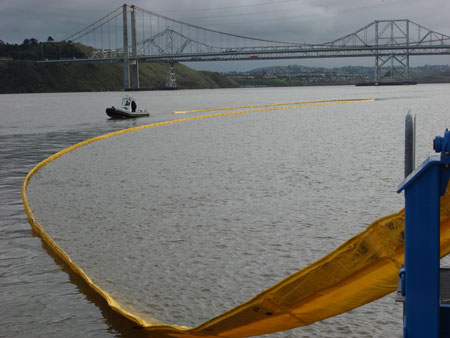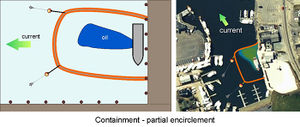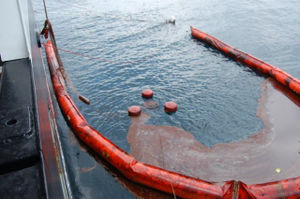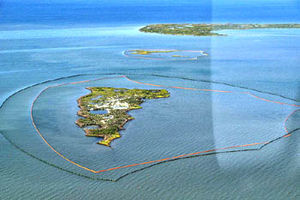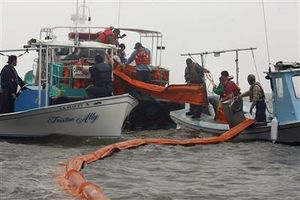Oil spill boom
Boom Overview
Boom is a common type of oil spill response equipment. It is used to protect shorelines or sensitive locations by acting as a barrier to oil, and to corral oil on the water to enhance the recovery effectiveness of skimmers or other response operations.
Although there is a great deal of variation in the design and construction of booms, all generally share the following four basic elements:
- An above-water "freeboard" to contain the oil and to help prevent waves from splashing oil over the top of the boom
- A flotation device
- A below-water "skirt" to contain the oil and help reduce the amount of oil lost under the boom
- A "longitudinal support," usually a chain or cable running along the bottom of the skirt, that strengthens the boom against wind and wave action; the support may also serve as a weight or ballast to add stability and help keep the boom upright.
How Boom is Used
Boom is used in many ways during an oil spill response. Booms can be fixed to a structure, such as a pier or a buoy, or towed behind or alongside one or more vessels. When stationary or moored, the boom is anchored below the water surface. It is necessary for stationary booms to be monitored or tended due to changes produced by shifting tides, tidal currents, winds, or other factors that influence water depth, direction, and force of motion. Boom tending requires round-the-clock personnel to monitor and adjust the equipment. The forces exerted by currents, waves, and wind may significantly impair the ability of a boom to hold oil. Currents may wash oil beneath a boom's skirt. Wind and waves can force oil over the top of the boom's freeboard or even flatten the boom into the water, causing it to release the contained oil. Mechanical problems and improper mooring can also cause a boom to fail.
Some general ways in which booms can be used include:
- Boom can be placed to exclude oil from a sensitive stretch of shoreline, such as a coastal marsh, marina, seabird nesting area, or location where marine mammals congregate. For example, boom may be placed across the mouth of a small inlet to prevent oil from entering the inlet, with anchors used to keep the boom in place. Boom placed to protect an area deflects oil; it does not collect it.
- Boom can be placed around a vessel or tank that is leaking oil. The boom confines the oil within a small space so it can be collected.
- Boom may also be towed behind boats to collect oil. Oil that collects in the apex of a towed U-shaped boom can either be skimmed from the water surface, or towed away from the main slick to location where it is safe to burn it.
Types of Boom
Four main types of boom are used for oil spill response.
Hard boom is typically made of PVC or similar durable material. It consists of an inflated chamber that rides above the water, and an attached skirt that hangs down into the water. The two main types of hard boom are ocean boom, designed for use in high seas, and harbor boom, designed for sheltered waters. The primary difference between ocean and harbor boom is the strength of the material, size of the flotation chamber, and depth of the skirt.
Hard boom is used to contain oil. It may be placed around a leaking vessel to corral oil, or anchored offshore of a sensitive area to exclude oil from that area. Hard boom also can be towed behind boats to concentrate oil so that skimmers can recover it.
Fire boom is similar in design to hard boom, but is made of material that can withstand the heat generated by burning oil, which can exceed 2,000º F. Fire boom is used to corral oil to be burned in an onsite (in situ) burn operation.
Sorbent boom looks like a long sausage. It is constructed of a long fabric sock enclosing material that attracts oil but repels water. Unlike hard boom, sorbent boom does not have an attached skirt. Once saturated with oil, sorbent boom must be removed and properly disposed of. It is used to both contain and absorb oil on the water surface.
Snare boom looks like cheerleaders’ pompoms tied to a long line. It is placed along shorelines, anchored by stanchions. The “pompom” strands catch tarballs and small quantities brought by tides and waves.
Effective Use of Boom
For several reasons, NOAA recommends that boom be deployed and maintained in a coordinated strategy with other response equipment. For one thing, not all areas can be protected by boom; other response measures must be adopted in those locations. And because there typically aren’t enough resources to protect all sensitive locations with boom, it is usually necessary to make tradeoffs when deciding where and when to place boom. For example, choosing to deploy boom to protect the entrance to an ecologically important coastal marsh rather than a recreational beach.
Because boom, once placed in the water, is difficult and time consuming to move, an effective strategy is to stage boom so that it is ready for deployment, but waiting to deploy until oil approaches the area. By using this strategy, responders can ensure that the boom is placed at the optimal location to protect against the oil, whether that location proves to be the originally envisioned site or a different location.
When boom is used to protect a shoreline, it must be tethered securely so that it will not be dislodged. Currents faster than 1.5 knots or even wakes from passing ships can dislodge boom. Rough seas and winds can tear, capsize, and shred boom. In some circumstances, lengthening a boom's skirt or freeboard can aid in containing the oil. However, because they have more resistance to natural forces such as wind, waves, and currents, these oversized booms are more prone to failure or leakage than are smaller ones. Generally, booms will not operate properly when waves are higher than one meter or currents are moving faster than one knot per hour. An effective method is to deploy concentric rings of boom to protect highly sensitive areas in exposed areas. In estimating the amount of boom needed to protect a given length of shoreline, responders then need to consider whether multiple rings of boom will be deployed.
Boom should never be set out and forgotten; deployed boom must be monitored to ensure that it remains in place. Untended boom can be a barricade to wildlife. For example, dislodged boom can strand on shorelines and prevent sea turtle adults and hatchlings from transiting between shore and water. Dislodged boom anchors can damage corals and sea grass beds. Untended boom also can become a barrier and hazard to ship traffic. Marinas and navigation channels must remain open for response vessels and commercial traffic.
Sorbent boom designed for oil spill response should be used whenever possible for most spill response uses, because it is specifically designed to collect spilled oil from the water surface. NOAA’s years of experience in oil spill response and field testing indicate that sorbent boom is much more effective than alternatives such as recycled nylon stockings stuffed with straw and hair.
In a February 2010 NOAA field test, commercial sorbent boom absorbed more oil and much less water than hair boom, which became waterlogged and sank within an hour. NOAA foresees a risk that widespread deployment of hair boom could exacerbate the marine debris problem in the Gulf of Mexico, in that waterlogged hair boom would be especially difficult to retrieve and more likely to break apart. It is possible that hair sorbents (absorbent pads) would be useful for collecting oil from drier areas such as rocks and artificial structures.

